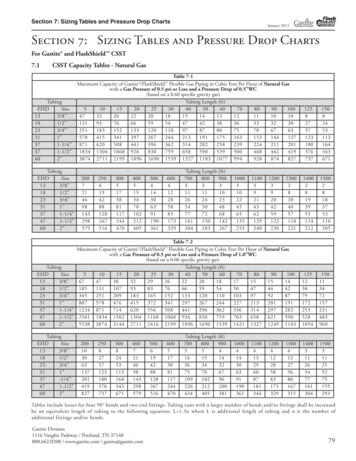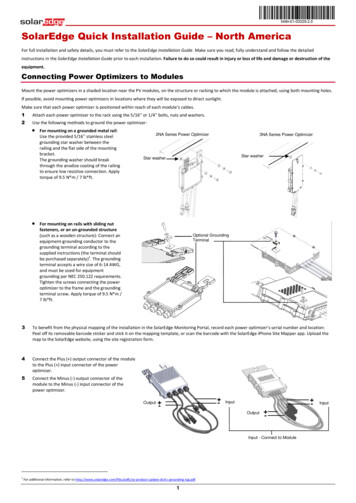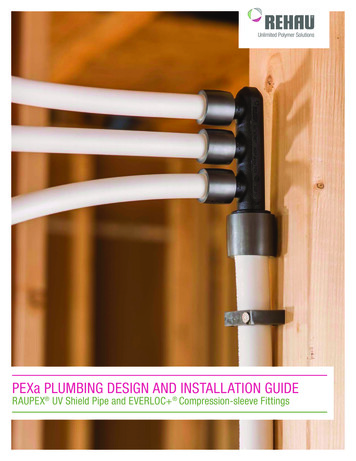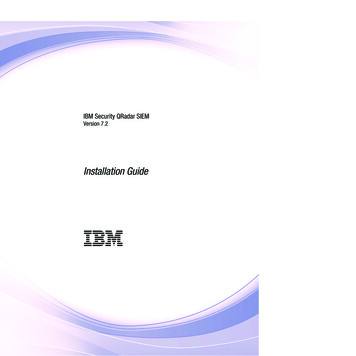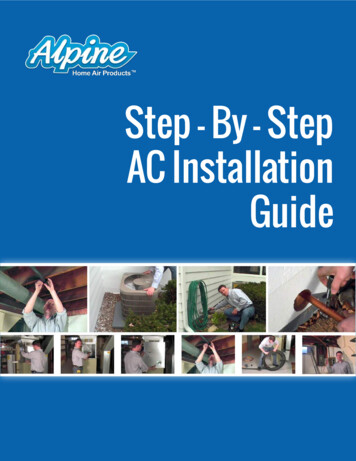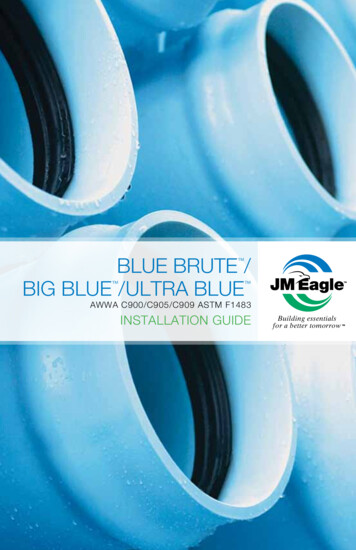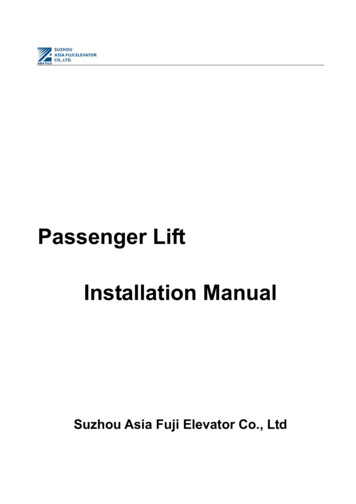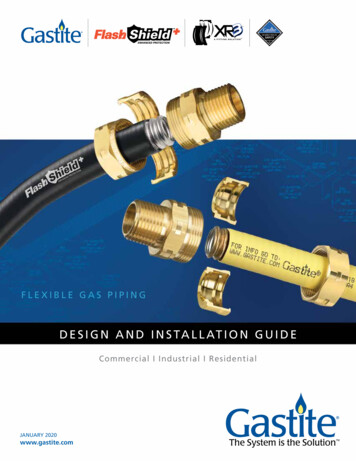
Transcription
FLEXIBLE GAS PIPINGD E S I G N A N D I N S TA L L AT I O N G U I D ECommercial I Industrial I ResidentialJANUARY 2020www.gastite.com
SECTION 1: INTRODUCTION / JANUARY 2020Important Lightning Safety WarningL IGH T NING SA F E T Y WA RNING1 PROPERLY BONDING and grounding theCorrugated Stainless Steel Tubing (CSST) systemmay reduce the risk of damage and fire from a lightningstrike. Lightning is a highly destructive force. Even anearby lightning strike that does not strike a structuredirectly can cause systems in the structure to becomeelectrically energized. Differences in potential betweensystems may cause the charge to arc between systems.Such arcing can cause damage to CSST, including holes.Bonding and grounding should reduce the risk of arcingand related damage. The building owner should confirmthat a qualified contractor has properly bonded theCSST gas system to the grounding electrode system ofthe premises. Refer to Section 4.10 Electrical Bonding/Grounding in the Gastite Design & Installation Guidefor details on bonding & grounding CSST.2 ALL OWNERS should consult a lightning safetyconsultant to determine whether installation of a lightning protection system would be required to achievesufficient protection for all building components fromlightning. Factors to consider include whether the areais prone to lightning. Areas with high lightning risk include but are not limited to: Alabama, Arkansas, Florida,Georgia, Illinois, Indiana, Iowa, Kentucky, Louisiana,Maryland, Michigan, Mississippi, Missouri, New Mexico, North Carolina, Ohio, Oklahoma, Pennsylvania, SouthCarolina, Tennessee, Texas, Virginia and West Virginia.One currently available source of information regarding areas more prone to lighting than others is the flashdensity map provided by the National Weather Servicewhich can be found at http://www.lightningsafety.noaa.gov/lightning map.htm. Lightning protection systemsare beyond the scope of this manual and installationguidelines, but are covered by National Fire ProtectionAssociation, NFPA 780, the Standard for the Installationof Lightning Protection Systems, and other standards.3 THE OWNER should confirm with the localgas supply utility company that a suitable dielectricunion is installed at the service entry of the structurebetween underground metallic piping and the gaspipes going into the building as required by code.www.gastite.com 2013, Gastite Division, Titeflex CorporationGENERAL 1/20/134 NATIONAL ELECTRIC CODE (NEC), Sec-tion 250.104b, states that “bonding all piping and metalair ducts within the premises will provide additionalsafety.” Gastite recommends that all continuous metallicsystems be bonded and grounded. The owner shouldconfirm with an electrical or construction specialistthat each continuous metallic system in a structure hasbeen bonded and grounded by an electrical professionalin accordance with local building codes. This shouldinclude, but is not limited to metallic chimney liners,metallic appliance vents, metallic ducting and piping,electrical cables, and structural steel.5 DIRECT CONTACT between continousmetallic systems and Gastite yellow CSST is prohibited.Maintain as much isolation/separation as reasonably possiblewhen planning and installing gas piping from othercontinuous metalllic systems. Refer to sec. 4.3Routing, in the Gastite D&I Guide for installationtechniques. Consult local building codes as to requiredseparations for CSST from such continuous metallic systemsincluding metallic chimney liners, metallic appliance vents,metallic ducting and piping, and insulated or jacketedelectrical wiring and cables. See for instance the IndianaResidential Code, section 675 IAC 14-4.3-155.5 SectionG2411.1; gas pipe bonding.6 LOCAL BUILDING CODES are controlling,however, as a general practice, fuel gas piping, includingCSST, should not be installed within a chase or enclosurethat houses a metallic chimney liner or appliance ventthat protrudes through the roof. In the event such aninstallation of Gastite yellow CSST is necessary and conformsto local building codes, the metallic chimney liner or vent mustbe bonded and grounded by a qualified electrical professional,and a separation distance, as specifically permitted by theapplicable local building code between the CSST andthe metallic chimney liner or vent, is required. Physicalcontact between CSST and the metallic chimney linerand/or vent is prohibited. If this physical separationcannot be specifically identified in the local buildingcode and achieved or any local building code requirements cannot be met along the entire length, thenrerouting of the CSST is required unless such installationis specifically permitted by the local building inspector.
INSTALLER INFORMATION & UPDATES1) Th e XR3-series fitting is designed to work on Gastite and FlashShield CSSTs. However, CSST end-prep variesby CSST product type. Reference the chart below for proper CSST end-prep and bushing placement for the productyou have selected.PRODUCTCSST END-PREPBUSHING PLACEMENTOne-StepEnd-PrepFlashShield or Gastite CSST2) L icensed Installers Only. Every installer of FlashShield or Gastite must first meet all applicable qualifications inaccordance with state and/or local requirements as established by the administrative authorities that enforce theplumbing or mechanical codes where gas piping is installed.3) Qualified Installers Only. In addition to be licensed in the jurisdiction, FlashShield or Gastite corrugated stainlesssteel tubing (CSST) flexible gas piping material must only be installed by an installer who has been successfullytrained through the FlashShield and Gastite training program.4) C heck for Updates. Installers should check with their local distributor or at www.gastite.com for technical bulletinsor updated Design & Installation Guides for FlashShield or Gastite every year.5) P roper Installation. Sound engineering principles and practices must be exercised for the proper design of fuel gaspiping systems, in addition to compliance with local codes. The installation instructions and procedures containedin this Design & Installation Guide must be strictly followed in order to provide a safe and effective flexible fuel gaspiping system or system modification. All installations must pass inspections by the local official having authorityprior to having the gas service turned on. All requirements of the local natural gas utility or propane supplier mustalso be met.FLASHSHIELD Metallic ShieldHigh Tensile PolyesterSemi-conductivePolymerElectrically InsulativePolymer
TABLE OF CONTENTS / JANUARY 2020 SECTION 1.0 INTRODUCTION1.1 GENERAL USER WARNINGS. 21.2 LIMITATIONS OF THE GUIDELINES. 51.3 STANDARDS, LISTINGS AND CODES. 5SECTION 2.0 SYSTEM DESCRIPTIONS & COMPONENTS2.1 SYSTEM DESCRIPTIONS. 62.1.1 GASTITE SYSTEM DESCRIPTION. 62.1.2 FLASHSHIELD SYSTEM DESCRIPTION. 72.2 COMPONENTS. 82.2.1 CORRUGATED STAINLESS STEEL TUBING. 8–92.2.2 FITTINGS.10–112.2.3 MANIFOLDS. 122.2.4 MODULAR STUB SYSTEM. 122.2.5 MOUNTING HARDWARE. 132.2.6 PIPE SUPPORT SYSTEM. 132.2.7 STRIKE PROTECTION. 142.2.8 SHUT-OFF VALVES AND QUICK CONNECTS . 142.2.9 GASTITE ACCESSORIES. 152.2.10 BONDING CLAMPS. 152.2.11 SYSTEM IDENTIFICATION. 152.2.12 REGULATORS. 16SECTION 3.0 SYSTEM CONFIGURATION3.1 CONFIGURATION. 183.1.1 INTRODUCTION. 183.1.2 SYSTEM REQUIREMENTS . 183.1.3 REFERENCE DATA FOR PROPER SYSTEM SIZING. 183.1.4 DETERMINING SYSTEM LAYOUT. 19–203.1.5 ALLOWABLE PRESSURE DROP. 213.1.6 SIZING METHODS. 21–223.1.7 MODIFYING AN EXISTING SYSTEM. 223.2 SIZING PROCEDURES AND EXERCISES. 223.2.1 SIZING EXAMPLES. 223.2.2 EXAMPLE 1: SERIES SYSTEM – 6"WC. 23–243.2.3 EXAMPLE 2: PARALLEL SYSTEM – 6"WC. 25–263.2.4 EXAMPLE 3: PARALLEL SYSTEM – 12-14"WC. 27–283.2.5 EXAMPLE 4: DUAL PRESSURE SYSTEM – 2 PSI TRUNK AND 8"WC APPLIANCE RUNS. 29–303.2.6 EXAMPLE 5: TANKLESS SIZING SYSTEM. 313.2.7 EXAMPLE 6: SERIES SYSTEM – 7"WC - HYBRID. 323.2.8 EXAMPLE 7: PARALLEL SYSTEM – 7"WC – HYBRID. 34–353.2.9 EXAMPLE 8: SUMMATION METHOD FOR PARALLEL SYSTEM – 7"WC – HYBRID. 36–373.2.10 EXAMPLE 9: SUMMATION METHOD FOR SERIES SYSTEM – 6"WC.38–403.2.11 EXAMPLE 10: COMMERCIAL ELEVATED PRESSURE SERIES SYSTEM – 2 PSI. 41–423.2.12 EXAMPLE 11: COMMERCIAL HYBRID SYSTEM – 7"WC. 43–45SECTION 4.0 INSTALLATION PRACTICES4.1 GENERAL PROVISIONS. 474.2 FIELD FITTING ASSEMBLY PROCEDURE. 484.2.1 XR3 FITTING REV.2 TO FLASHSHIELD CSST OR GASTITE YELLOW CSST (WITH JACKET STRIPPING TOOL).48–494.2.2 XR3 FITTING REV.2 TO FLASHSHIELD CSST OR GASTITE YELLOW CSST (WITH UTILITY KNIFE). 50–514.2.4 OTHER ACCESSORY INSTALLATION. 524.3 ROUTING. 534.3.1 VERTICAL RUNS. 534.3.2 HORIZONTAL RUNS. 534.3.3 INSTALLATION CLEARANCE HOLES. 534.3.4 CONCEALED FITTINGS. 544.3.5 MODIFICATIONS TO EXISTING SYSTEMS. 544.3.6 OUTDOOR. 55ivGASTITE DIVISION, TITEFLEX CORPORATION / 1116 Vaughn Parkway / Portland, TN 37148800.662.0208 / www.gastite.com / gastite@gastite.com
TABLE OF CONTENTS / JANUARY 20204.3.7 FIRE RATED CONSTRUCTIONS. 554.3.8 ROUTING THROUGH MASONRY MATERIAL. 554.3.9 INSTALLATION WITHIN A CHASE. 554.3.10 CLEARANCE FROM THE UNDERSIDE OF A ROOF DECK. 554.4 STRIKE PROTECTION. 564.4.1 STRIKE PLATES. 56–574.4.2 STEEL CONDUIT. 584.5 METER. 584.6 APPLIANCE. 594.6.1 MOVEABLE APPLIANCE . 594.6.2 DIRECT CONNECTION – NON-MOVEABLE APPLIANCES. 604.6.3 GAS CONVENIENCE OUTLET. 604.6.4 SPECIAL APPLICATIONS. 61–644.7 MANIFOLD. 654.8 PRESSURE REGULATOR. 664.8.1 INTRODUCTION. 664.8.2 SIZING INSTRUCTIONS.66–674.8.3 INSTALLATION. 684.8.4 PERFORMANCE. 694.8.5 REGULATOR OUTLET PRESSURE ADJUSTMENT. 694.8.6 OVER-PRESSURIZATION PROTECTION. 694.9 UNDERGROUND INSTALLATIONS. 704.10 ELECTRICAL BONDING OF GASTITE/FLASHSHIELD CSST. 71SECTION 5.0 INSPECTION, REPAIR & REPLACEMENT5.1 MINIMUM INSPECTION REQUIREMENTS. 725.2 INSTALLATION CHECKLIST DESCRIPTION. 735.3 REPAIR OF DAMAGED CSST. 745.3.1 DETERMINE DAMAGE. 745.3.2 METHOD OF REPAIR. 745.3.3 FLASHSHIELD JACKET REPAIR. 74SECTION 6.0 PRESSURE/LEAKAGE TESTING6.1 GENERAL GUIDELINES FOR PRESSURE TESTING. 756.2 ELEVATED PRESSURE SYSTEMS. 756.3 APPLIANCE CONNECTION LEAKAGE CHECK PROCEDURE. 76SECTION 7.0 SIZING TABLES & PRESSURE DROP CHARTS7.1 CSST CAPACITY TABLES—NATURAL GAS. 77–807.2 CSST CAPACITY TABLES—NATURAL GAS—ELEVATED PRESSURE. 81–827.3 CSST CAPACITY TABLES—PROPANE GAS. 83–857.4 CSST CAPACITY TABLES—PROPANE GAS—ELEVATED PRESSURE. 85–867.5 GASTITE AND FLASHSHIELD CSST PRESSURE DROP TABLES. 87–887.6 IRON PIPE CAPACITY TABLES. 917.7 IRON PIPE PRESSURE DROP TABLES.92-957.8 REFERENCE DATA. 96SECTION 8.0 DEFINITIONS. 97–98SECTION 9.0 DIMENSIONAL & TECHNICAL REFERENCE DATA. 999.1 GASTITE SPECIFICATION SHEET. 1009.2 FLASHSHIELD SPECIFICATION SHEET. 101SECTION 10.0 WARRANTY. 102GASTITE DIVISION, TITEFLEX CORPORATION / 1116 Vaughn Parkway / Portland, TN 37148800.662.0208 / www.gastite.com / gastite@gastite.comv
SECTION 1: INTRODUCTION / JANUARY 2020SECTION 1.0 INTRODUCTION1.1GENERAL USER WARNINGSThe installation of Gastite or FlashShield Flexible Gas Piping must be performed by a qualified installer who hassuccessfully completed the Gastite/FlashShield training program. Certification training is available through qualifieddistributors, and at www.gastite.com. The installer must meet all qualifications and requirements to install gas piping asrequired by the local administrative authority. Improper installation or operation of a Gastite or FlashShield Flexible GasPiping system may result in fire, explosion or asphyxiation. WARNING: This product can expose you to chemicals including Lead, and Nickel, which are known to theState of California to cause cancer and birth defects or other reproductive harm. For more information go towww.P65Warnings.ca.gov.This document provides the user with general guidance when designing and installing fuel gas piping using Gastite or FlashShield Flexible Gas Piping. This guideline must be used in conjunction with all applicable building standardsand codes. In the event that there is a conflict between this guideline and local code the more stringent requirement willtake precedence.The use of fuel gas can be dangerous. Special attention must be given to the proper design, installation, testing andapplication of the gas piping system. Sound engineering practices and principles must be exercised, as well as diligentadherence to the proper installation procedures to ensure the safe operation of the piping system. All installed systems mustpass customary installation inspections by the local building official having authority prior to being placed into service.Only the components provided or specified by Gastite as part of the Gastite/FlashShield flexible fuel piping system areto be used in the installation. Use of components from other flexible gas piping systems other than those specified as partof the Gastite/FlashShield system is prohibited and may result in poor system performance and serious bodily injuryor property damage. Where additions, repairs or replacements involve corrugated stainless steel tubing systems frommanufacturers other than Gastite Division, the systems should be joined using standard pipe fittings at the interface.This manual cannot take into account all situations or locations in which Gastite/FlashShield flexible gas piping will beinstalled. Accordingly, installers should also take into account guidance provided by the National Fuel Gas Code, ANSIZ223.1/NFPA-54, National Standard of Canada, Natural Gas and Propane Installation Code, B149.1, the UniformPlumbing Code, the International Code Series, the Federal Manufactured Home Construction and Safety Standards,24 CFR Part 3280, the Manufactured Housing Construction and Safety Standards, ICC/ANSI 2.0 or the Standardon Manufactured Housing, NFPA 501. Gastite Division shall have no responsibility for any misinterpretation of theinformation contained in this guide or any improper installation or repair work or other deviation from proceduresrecommended in this manual, whether pursuant to local building codes or engineering specifications or otherwise.Gastite Division makes no representation or warranty, and nothing contained in this manual shall imply that this manualcontains the best or the only approved method for installing corrugated stainless steel piping systems or that this manual’scontents are appropriate for all circumstances. In the event that there is a conflict between this guideline and local code themore stringent requirement will take precedence. Performance of accessory devices, such as pressure regulators and shutoff valves should be reconfirmed by contacting the accessory device manufacturer and receiving the latest technical data onsizing, installation and performance.2GASTITE DIVISION, TITEFLEX CORPORATION / 1116 Vaughn Parkway / Portland, TN 37148800.662.0208 / www.gastite.com / gastite@gastite.com
SECTION 1: INTRODUCTION / JANUARY 20201.1GENERAL USER WARNINGS (CONTINUED)A Gastite/FlashShield Flexible Gas Piping system offers advantages over other gas delivery systems because of itscorrugated design. In contrast to rigid steel pipe, Gastite/FlashShield does not require intermediate joints in mostinstallations because the tubing is capable of being installed in one continuous run, reducing not only the total numberof joints, but also the potential for leaks at joints. Gastite/FlashShield flexibility also affords more installation optionsbecause an installer can avoid existing obstacles, and it eliminates the repetitive measuring, cutting, threading and jointassembly that is common with installation of rigid steel piping systems. Gastite/FlashShield ’s flexibility offers even furthersafety advantages in geographic areas that are prone to seismic activity because the tubing is able to move as the ground orthe structure shifts.While Gastite/FlashShield provides significant advantages over more rigid gas delivery systems, its flexible design maymake it more likely than steel pipe to be punctured by a nail or other sharp objects, or damaged by other extraordinaryforces such as lightning strike, depending on the circumstances.Properly bonding and grounding the Corrugated Stainless Steel Tubing (CSST) system may reduce the risk ofdamage and fire from a lightning strike. Lightning is a highly destructive force. Even a nearby lightning strike thatdoes not strike a structure directly can cause systems in the structure to become electrically energized. Differencesin potential between systems may cause the charge to arc between systems. Such arcing can cause damage to CSST,including holes. Bonding and grounding should reduce the risk of arcing and related damage. The building owner shouldconfirm that a qualified contractor has properly bonded the CSST gas system to the grounding electrode system of thepremises. Refer to Section 4.10 Electrical Bonding/Grounding in the Gastite/FlashShield Design & Installation Guidefor details on bonding & grounding CSST.All owners should consult a lightning safety consultant to determine whether installation of a lightning protection systemwould be required to achieve sufficient protection for all building components from lightning. Factors to consider includewhether the area is prone to lightning. Areas with high lightning risk include but are not limited to: Arkansas, Florida,Georgia, Illinois, Indiana, Iowa, Kentucky, Louisiana, Maryland, Michigan, Mississippi, Missouri, New Mexico, NorthCarolina, Ohio, Oklahoma, Pennsylvania, South Carolina, Tennessee, Texas and West Virginia. One currently availablesource of information regarding areas more prone to lighting than others is the flash density map provided by the NationalWeather Service which can be found at http://www.lightningsafety.noaa.gov/lightning map.htm. Lightning protectionsystems are beyond the scope of this manual and installation guidelines, but are covered by National Fire ProtectionAssociation, NFPA 780, the Standard for the Installation of Lightning Protection Systems, and other standards. The ownershould confirm with the local gas supply utility company that a suitable dielectric union is installed at the service entry ofthe structure between underground metallic piping and the gas pipes going into the building as required by code.Section 250.104b of the National Electric Code (NEC) states that “bonding all piping and metal air ducts withinthe premises will provide additional safety.” Gastite recommends that all continuous metallic systems be bonded and
Grounding in the Gastite Design & Installation Guide for details on bonding & grounding CSST. 2 ALL OWNERS should consult a lightning safety consultant to determine whether installation of a light-ning protection system would be required to achieve sufficie


